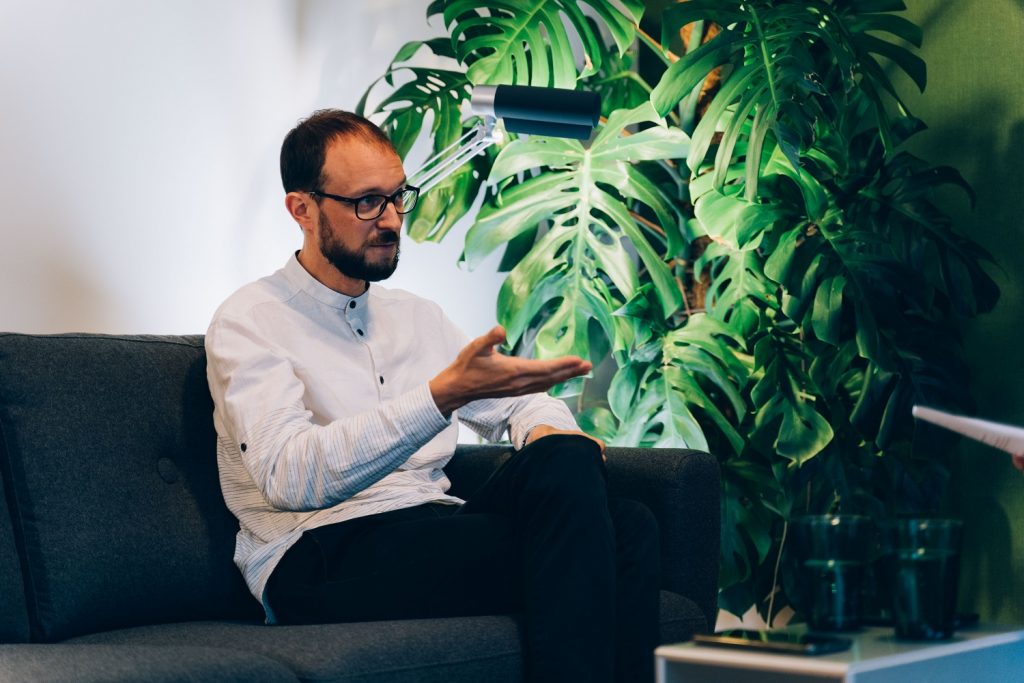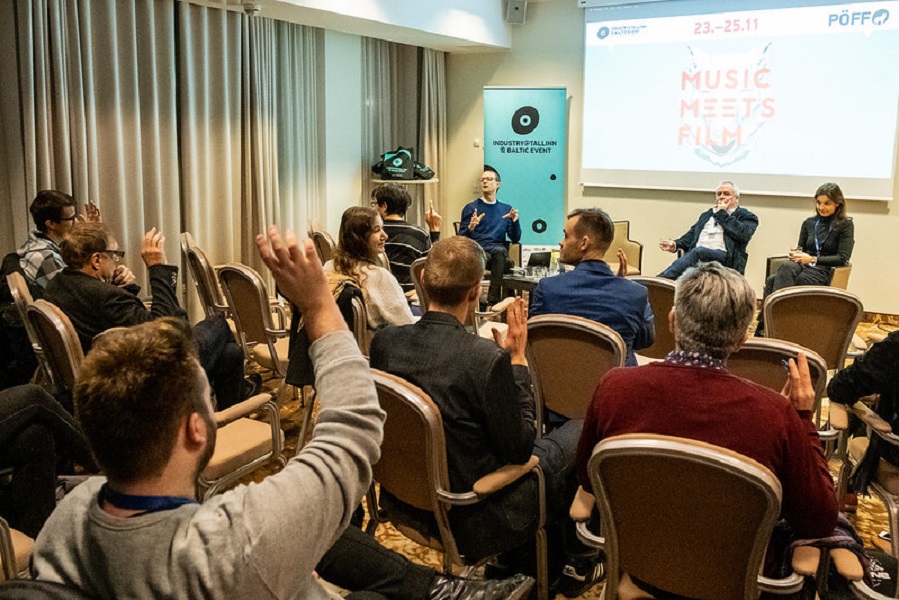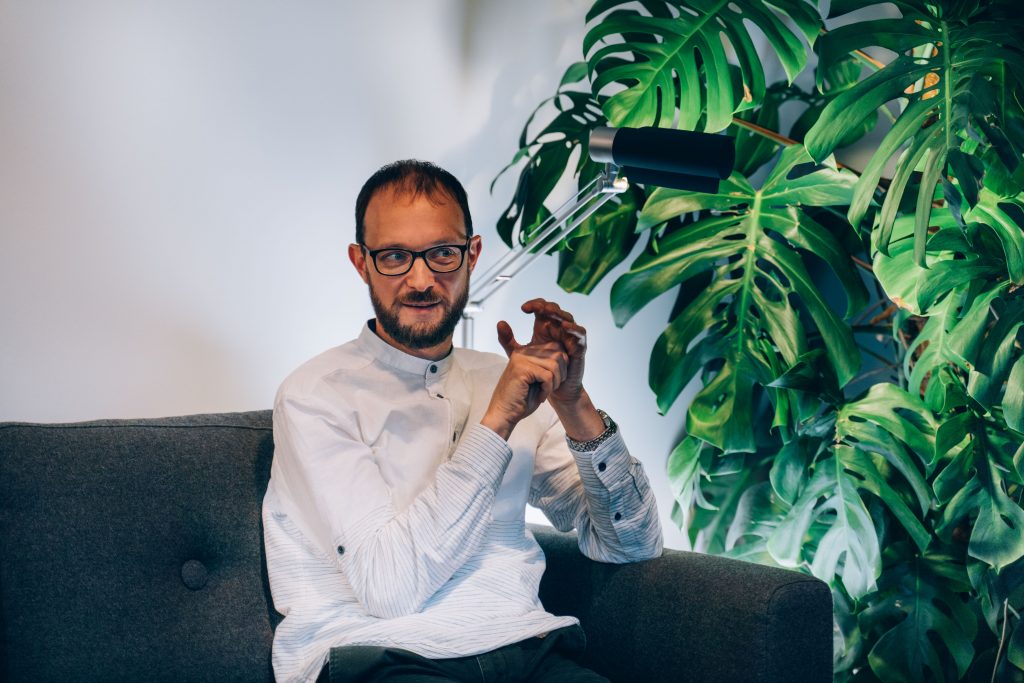Michael Pärt, the curator of the Music Meets Film programme, talks to Estonian World about his work and the Estonian film and film music industry in general.
This article is published in collaboration with Filmus.
Would you imagine meeting someone who has worked with international Oscar and Grammy-nominated talents – musicians like Björk and Arcade Fire, or film directors Peter Jackson, Francis Ford Coppola and film music composer Howard Shore. The Estonian music producer, Michael Pärt, is just that person and he’s very modest about his work. He grew up in Germany and received his master’s degree at Kingston University in London. His family lived until 2007 in Iceland but has now settled in Estonia where Michael has been most recently active in the centre dedicated to his father – the Arvo Pärt Centre.
For the eighth year in a row, the Music Meets Film programme takes place alongside the Tallinn Black Nights Film Festival in November and Michael Pärt has been curating the process for the last three years. The initiative is aimed at composers and directors; from music and sound creatives through to producers, agents and the wider music and film industry. Where is the Estonian film and film music industry going, what are relevant issues and who are the guests at this years’ Music Meets Film?
Let’s talk about the film industry in Estonia – are there any benefits for a small industry?
There are lots of benefits. First, a smaller industry can be very versatile. For example, we see how Estonia has embraced technology and has built up infrastructure from zero from just a few decades ago. It started at the right time – which also coincided with the birth of the internet.
If one wants to be versatile and push something through, then a small country can give you that freedom. Basically, you know everyone in your pool. Obviously, there is a silver lining to that, too. The more free and compact you are, the smaller the pool of competency. It’s just a matter of mathematics. Obviously, this is not a general stance, but rather a guide. If you look at film industries in larger countries, let’s say the England or France, you see how the competition, both positive and negative, pushes the standard of the industry, purely by its nature.
We see it quite often when larger productions come to Estonia, such as with Christopher Nolan’s recent “Tenet” film. There is so much excitement – just remember that elsewhere it’s complete normality. We have the ability to learn from these competencies that are brought here. When larger productions come, the local film industry can embrace and learn from these opportunities. Take it as a glass half full whilst remembering that this is often normality elsewhere.
What are the possibilities for the Estonian film industry to grow and become more international?
In the most recent case, when Nolan was in Tallinn, he set an entire process into motion. His methods and expectations don’t get questioned. He requests it, there is a budget for it, and it happens; the order of decision making, how the politics are run and budgets are being managed.
Within each type of profession that is employed in the film industry, some of the knowhow stays here following the production. During these projects, new networks are being established, and we see how Nolan takes some of his new Estonian crew with him to his next films. A new branch of this tree is formed – it has its own life and shape – we see these people develop new skills sets and eventually return home. This is what will make the Estonian film industry more competitive. The smaller you are, the more you have to think outside the box.
Some people have been asking if there is a danger of losing the creative spirit and connection to a deeper sense of art, cinematography and so on… I don’t think this is the case in our specific context, as long as you don’t lose the balance between your original creative impulse among the distractions of budgeting and managing politics.

Why should our industry experts take part in programmes like Music Meets Film?
For quite a number of reasons. First and foremost, the Estonian film music industry has been practically non-existent in an international context, compared with many other territories. Every single one of our neighbours, even the other Baltic nations, have decades of experience in film music recording for international productions. Scores would be recorded in Latvia, the Czech Republic, Austria, Poland, Hungary and many more – and all of this since the late 90s.
They are more than 20 years ahead of us and have through countless collaborations been extending their own networks. How many Estonian film and film music experts reach how wide of a network outside of Estonia? Not many, not wide. If the opposite would happen, there would be a snowball effect that would self-perpetuate and grow. And to get there is the main reason of having this thirst of inviting people from afar to connect with the industry here in Estonia. The guests I invite to Music Meets Film are not specialists in the abstract sense but rather practising experts, who want to come here and share their skills.
How is the interest for taking part?
I’d like to see the interest more than it has been in the past. I can see a certain difference in approach across different generations. We have composers of tomorrow who have a lot of enthusiasm. We also have very young composers of today who are very eager to connect and to stay in touch, to hear new ideas, processes, styles. There is a certain open mindedness and the willingness to extend their network reach.
From some other generations and from some more established composers, I have not seen the same enthusiasm that would get them to be in touch with people from beyond the Estonian “pool”. It’s a question of generation and mindset. Our Estonian mentality. The idea of going out there, speak to people and make new friends and continue from there… is rather alien to us. Many other people do better than Estonians in this regard.
If the industry is to increase its competitive edge, we should not forget the topic of tax rebates, which in turn will inevitably bring us to the age-old question of why taxpayers’ money should be spent on film production rebates. It is exactly for that: to increase the competitiveness of the local film industry. You see, the beauty of the film industry as a whole, is that it engages a healthy crosscut of practically every trade within society. Everyone can be somehow connected to film. We can see drivers, researchers, plumbers, designers, carpenters, writers and so many more. It takes time to see the return on investment, just as with other initiatives such as Enterprise Estonia (a state-run agency responsible for promoting Estonia abroad and attracting investment – editor).
Currently, my main priority is to extend the scope and target group of Music Meets Film within Estonia. Establish stronger relationships with organisations. Strengthen the ties with the Estonian Academy of Music and Theatre, the Baltic Film and Media School, the Estonian Composers Union and other institutions. Programmes such as Music Meets Film are a positive tool kit for the students, who can become more competitive with building on this network. The Estonian Academy of Music plans to put Music Meets Film programming in its curriculum for the academic year 2020/2021 and the Baltic Film and Media School as well. I would like to see entire classes there and the programme being part of their timetable.
In the years to follow I would like to see stronger institutional ties between the music and film academies and Music Meets Film within a broader region – focusing on Scandinavia, the Baltics, Russia and other countries.

Let’s talk about Music Meets Film this year. What is the focus?
Music Meets Film is in its eighth year and it’s the third year I’m curating it. When I started, I wanted to bring a certain programme structure to it. We start our three-day programme with an introduction and a broader discussion on current affairs, which is followed by the main topic we focus on during any given year. Our last day centres on a more academic approach, with workshops and master classes. Our focus this year is centred on composers – the source of creativity for a composer, how they hear their music in their head, how they see the film within a music context, how directors and composers relate and understand each other’s guidelines.
Then there is a special side-topic this year by forensic musicologist Peter Oxendale who will lay out the pitfalls of the director’s attachment to a temporary score, and the subsequent dilemma for the composer of staying away from plagiarism. We have all seen movies their proudly feature “their” Forrest Gump or Shawshank Redemption versions! These are all moments when you recognise the temp score.
How do you choose the experts?
First, I like to see a certain kind of programming rhythm across several years, while avoiding similar topics too close to each other. Last year, we looked into collaboration, teams and workflow. This year, we have compositions, composers and how to compose to a brief. It’s a very exciting process. I am already now discussing with the speakers of this year’s MMF trends and possible topics that will become food for thought for next year: MMF2020. I also want to hear thoughts from the students and listeners.
In a longer-term plan, I’d like to look into live music. It requires a different kind of support, budget and terms. There are many ways to implement live music. It is often said that film music should work just as well within a film as it would outside a film context. Another aspect and a technically more challenging one is “live to projection”. Having the orchestra playing the score live – it adds all of the elements of musicality, interpretation and connection to performance within the context of film.
However, live to projection shouldn’t be taken lightly because it’s a huge undertaking. If you don’t bear this way of performing in mind during the initial score production, and no one usually has the time nor the budget to worry about that, then preparing the scores and the process with rehearsing for live projection is often not less of a project than the original film music production in the first place…

But how would you see the future of the Estonian film music industry and its relationship with Music Meets Film?
What is really an essential part of the entire initiative, is already in place today: a platform where creative professionals can return year after year. As the footprint grows and becomes stronger, so will the element of Music Meets Film – of becoming a meeting place for film composers, film directors, producers and others among themselves. There haven’t been film composers in the world who wouldn’t have called up their best friend (and maybe closest competitor) at the 11th hour and said: “You’ve got to help me. Can you write a cue, I gotta send it off to the director at 8 in the morning. Can you take care of this one track?” Today you might call them, tomorrow they will call you for a favour, and before you know it, you are a team co-scoring a feature…
This is also a good entry point for people outside film music who would like to enter this field. We shouldn’t underestimate the many young directors to whom I would also like to reach out to: they have their own challenges on how to best understand and direct music. At a student level, our collaboration with the Baltic Film and Media School is to start this very discussion from the ground up. Or the editor: on how to plan the narrative of the film, the tempo of the scene, the contrasts of the characters – and how they all have a direct relationship with the music. Even the script writer cannot stay unaffected.
When Mike Newell, the director of “Four Weddings and a Funeral”, was talking about collaboration at last year’s MMF, a Baltic Film and Media School student was asking for directing advice. Three hours later, when the official programme was over, that student brought over 50 of his peers and we saw an impromptu masterclass on how to direct actors – to everybody’s surprise. Even if this question wasn’t musically driven, when I saw how somebody of Mike Newell’s level was explaining to a young film student how to direct – let’s just say it was very musical, I understood him and how it can apply to music. The rules and the grammar are the same.
Different communities can meet. At a deeper level we all understand each other’s craft, be it an actor following a director’s initiative, a composer following the director’s lead, or the musicians following the conductor’s baton. Film music is one of many avenues to get closer to understanding these vastly different worlds that share so many common denominators. This allows for a creative coexistence across all of them.
The programme for Music Meets Film can be found on its website.
Music Meets Film is taking place for the eighth time in 2019 and this year’s focus is on a film music composers’ source of creativity. The initiative brings together composers and directors; from music and sound creatives through to producers, agents and the wider music and film industry. It is to build bridges between creatives, grow as an interdisciplinary meeting place and encourage new international collaborations. Music Meets Film invites acclaimed industry professionals who share their insights on what are the current trends in film scoring and how film music industry operates through talks, mentorship sessions and open panels.Music Meets Film dates for 2019 are 25-27 November.
Cover: Michael Pärt. Photo by Ingrid Kerson.

